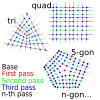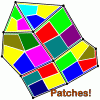BentFX
New Member
- Messages
- 116
- Reaction score
- 0
- Points
- 0
OK, heres the deal...
Let's recreate the wheel and recreate it better!
I'm working on a project where I'm dealing with catmull-clark subdivision of polygons... in C++. I'm looking for an ingenious algorithm to keep track of points and faces for subdivided 3D faces. To subdivide each face, a point is plotted at the center of the face and edges are created to the midpoint of each edge of the face. And it must take into account that the algorithm is recursive(ie. subdivided faces can be subdivided again on recursive passes)
Talk to me about the patterns you see in the attached image...

It is really a lot more involved than what I've said, but truly, talk to me, and we'll work out the deeper considerations as we go.
It is a simple routine... place a point in the center of the face and split new edges to each face-edge...
Anyone... Come on... help me out with this!
Thanks,
Skip
Let's recreate the wheel and recreate it better!
I'm working on a project where I'm dealing with catmull-clark subdivision of polygons... in C++. I'm looking for an ingenious algorithm to keep track of points and faces for subdivided 3D faces. To subdivide each face, a point is plotted at the center of the face and edges are created to the midpoint of each edge of the face. And it must take into account that the algorithm is recursive(ie. subdivided faces can be subdivided again on recursive passes)
Talk to me about the patterns you see in the attached image...
It is really a lot more involved than what I've said, but truly, talk to me, and we'll work out the deeper considerations as we go.
It is a simple routine... place a point in the center of the face and split new edges to each face-edge...
Anyone... Come on... help me out with this!
Thanks,
Skip






